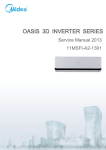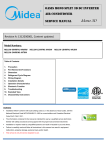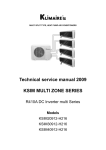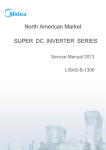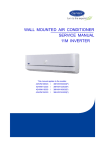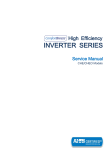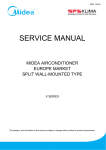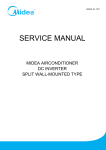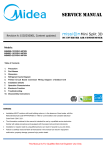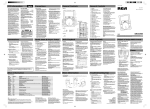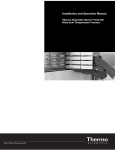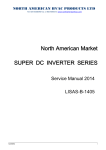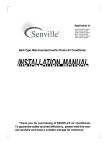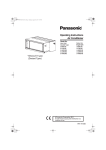Download Mission 3D Inverter Series
Transcript
Mission 3D Inverter Series Service Manual 2014 MBSEU-A-1412 CONTENTS 1. Precaution .................................................................................................................................................... 3 1.1 Safety Precaution .......................................................................................................................... 3 1.2 Warning ......................................................................................................................................... 3 2. Function ........................................................................................................................................................ 6 3. Dimension .................................................................................................................................................... 7 3.1 Indoor Unit..................................................................................................................................... 7 3.2 Outdoor Unit ................................................................................................................................ 10 4. Refrigerant Cycle Diagram ....................................................................................................................... 13 5 Installation Details ...................................................................................................................................... 14 5.1 Wrench torque sheet for installation ........................................................................................... 14 5.2 Connecting the cables ................................................................................................................ 14 5.3 Pipe length and the elevation ..................................................................................................... 15 5.4 Installation for the first time ......................................................................................................... 16 5.5 Adding the refrigerant after running the system for many years ................................................ 17 5.6 Re-installation while the indoor unit need to be repaired ........................................................... 18 5.7 Re-installation while the outdoor unit need to be repaired ......................................................... 19 6. Operation Characteristics ......................................................................................................................... 21 7. Electronic function .................................................................................................................................... 22 7.1 Abbreviation ................................................................................................................................ 22 7.2 Display function ........................................................................................................................... 22 7.3 Main Protection ........................................................................................................................... 23 7.4 Operation Modes and Functions................................................................................................. 24 8. Troubleshooting ......................................................................................................................................... 28 8.1 Indoor Unit Error Display............................................................................................................. 29 8.2 Trouble shooting.......................................................................................................................... 30 1. Precaution 1.1 Safety Precaution To prevent injury to the user or other people and property damage, the following instructions must be followed. Incorrect operation due to ignoring instruction will cause harm or damage. Before service the unit, be sure to read this service manual at first. 1.2 Warning Installation Do not use a defective or underrated circuit breaker. Use this appliance on a dedicated circuit. There is risk of fire or electric shock. For electrical work, contact the dealer, seller, a qualified electrician, or an authorized service center. Do not disassemble or repair the product, there is risk of fire or electric shock. Always ground the product. There is risk of fire or electric shock. Install the panel and the cover of control box securely. There is risk of fire of electric shock. Always install a dedicated circuit and breaker. Improper wiring or installation may cause fore or electric shock. Use the correctly rated breaker of fuse. There is risk of fire or electric shock. Do not modify or extend the power cable. There is risk of fire or electric shock. Do not install, remove, or reinstall the unit by yourself (customer). There is risk of fire, electric shock, explosion, or injury. Be caution when unpacking and installing the product. Sharp edges could cause injury, be especially careful of the case edges and the fins on the condenser and evaporator. For installation, always contact the dealer or an authorized service center. Do not install the product on a defective installation stand. Be sure the installation area does not deteriorate with age. If the base collapses, the air conditioner could fall with it, causing property damage, product failure, and personal injury. Do not let the air conditioner run for a long time when the humidity is very high and a door or a window is left open. Take care to ensure that power cable could not be pulled out or damaged during operation. There is risk of fire or electric shock. Do not place anything on the power cable. There is risk of fire or electric shock. Do not plug or unplug the power supply plug during operation. There is risk of fire or electric shock. Do not touch (operation) the product with wet hands. Do not place a heater or other appliance near the power cable. There is risk of fire and electric shock. Do not allow water to run into electrical parts. It may cause fire, failure of the product, or electric shock. Do not store or use flammable gas or combustible near the product. There is risk of fire or failure of product. Do not use the product in a tightly closed space for a long time. Oxygen deficiency could occur. When flammable gas leaks, turn off the gas and open a window for ventilation before turn the product on. If strange sounds or smoke comes from product, turn the breaker off or disconnect the power supply cable. There is risk of electric shock or fire. Stop operation and close the window in storm or hurricane. If possible, remove the product from the window before the hurricane arrives. There is risk of property damage, failure of product, or electric shock. Do not open the inlet grill of the product during operation. (Do not touch the electrostatic filter, if the unit is so equipped.) There is risk of physical injury, electric shock, or product failure. When the product is soaked, contact an authorized service center. There is risk of fire or electric shock. Be caution that water could not enter the product. There is risk of fire, electric shock, or product damage. Ventilate the product from time to time when operating it together with a stove etc. There is risk of fire or electric shock. Turn the main power off when cleaning or maintaining the product. There is risk of electric shock. When the product is not be used for a long time, disconnect the power supply plug or turn off the breaker. There is risk of product damage or failure, or unintended operation. Take care to ensure that nobody could step on or fall onto the outdoor unit. This could result in personal injury and product damage. CAUTION Always check for gas (refrigerant) leakage after installation or repair of product. Low refrigerant levels may cause failure of product. Install the drain hose to ensure that water is drained away properly. A bad connection may cause water leakage. Keep level even when installing the product. It can avoid vibration of water leakage. Do not install the product where the noise or hot air from the outdoor unit could damage the neighborhoods. It may cause a problem for your neighbors. Use two or more people to lift and transport the product. Do not install the product where it will be exposed to sea wind (salt spray) directly. It may cause corrosion on the product. Corrosion, particularly on the condenser and evaporator fins, could cause product malfunction or inefficient operation. Operational Do not expose the skin directly to cool air for long time. (Do not sit in the draft). Do not use the product for special purposes, such as preserving foods, works of art etc. It is a consumer air conditioner, not a precision refrigerant system. There is risk of damage or loss of property. Do not block the inlet or outlet of air flow. Use a soft cloth to clean. Do not use harsh detergents, solvents, etc. There is risk of fire, electric shock, or damage to the plastic parts of the product. Do not touch the metal parts of the product when removing the air filter. They are very sharp. Do not step on or put anything on the product. (outdoor units) Always insert the filter securely. Clean the filter every two weeks or more often if necessary. A dirty filter reduces the efficiency of the air conditioner and could cause product malfunction or damage. Do not insert hands or other objects through air inlet or outlet while the product is operated. Do not drink the water drained from the product. Use a firm stool or ladder when cleaning or maintaining the product. Be careful and avoid personal injury. Replace the all batteries in the remote control with new ones of the same type. Do not mix old and new batteries or different types of batteries. There is risk of fire or explosion. Do not recharge or disassemble the batteries. Do not dispose of batteries in a fire. They may burn of explode. If the liquid from the batteries gets onto your skin or clothes, wash it well with clean water. Do not use the remote of the batteries have leaked. 2. Function Model Names of Indoor/Outdoor Units 3D inverter Capacity Indoor units Outdoor units 9k MSMBAU-09HRFN1-QRD0GW MOB01-09HFN1-QRD0GW 12k MSMBBU-12HRFN1-QRD0GW MOB01-12HFN1-QRD0GW 18k MSMBCU-18HRFN1-QRD0GW MOB01-18HFN1-QRD0GW 24k MSMBDU-24HRFN1-QRD0GW MOF2-24HFN1-QRD0GW 3. Dimension 3.1 Indoor Unit Model W D H MSMBAU-09HRFN1-QRD0GW 730 198 293 MSMBBU-12HRFN1-QRD0GW 810 200 300 MSMBCU-18HRFN1-QRD0GW 980 225 325 MSMBDU-24HRFN1-QRD0GW 1090 235 338 For MSMBAU-09HRFN1-QRD0GW: For MSMBBU-12HRFN1-QRD0GW: For MSMBCU-18HRFN1-QRD0GW: For MSMBDU-24HRFN1-QRD0GW: 3.2 Outdoor Unit More than 30cm More than 60cm (Service space) More than 30cm Fe n ob ce o sta r cle s More than 60cm More than 200cm For MOB01-09HFN1-QRD0GW, MOB01-12HFN1-QRD0GW, MOB01-18HFN1-QRD0GW, For MOF2-24HFN1-QRD0GW, Model W D H W1 A B MOF2-24HFN1-QRD0GW 845 320 700 908 560 335 4. Refrigerant Cycle Diagram INDOOR OUTDOOR CHECK VALVE (Heating Model only) LIQUID SIDE 2-WAY VALVE CAPILIARY TUBE HEAT EXCHANGE (EVAPORATOR) HEAT EXCHANGE (CONDENSER) T1 Room temp. sensor T2 Evaporator temp. sensor GAS SIDE 4-WAY VALVE 3-WAY VALVE ACCUMULATOR COOLING COMPRESSOR HEATING 5 Installation Details 5.1 Wrench torque sheet for installation Outside diameter Torque Additional tightening torque mm inch N.cm N.cm Ф6.35 1/4 1500(153kgf.cm) 1600(163kgf.cm) Ф9.52 3/8 2500(255kgf.cm) 2600(265kgf.cm) Ф12.7 1/2 3500(357kgf.cm) 3600(367kgf.cm) Ф15.9 5/8 4500(459kgf.cm) 4700(479kgf.cm) Ф19 3/4 6500(663kgf.cm) 6700(683kgf.cm) 5.2 Connecting the cables The power cord of connect should be selected according to the following specifications sheet. Rated current of appliance Nominal cross-sectional area (mm²) >3 and ≤6 0.75 >6 and ≤10 1 >10 and ≤16 1.5 >16 and ≤25 2.5 The cable size and the current of the fuse or switch are determined by the maximum current indicated on the nameplate which located on the side panel of the unit. Please refer to the nameplate before selecting the cable, fuse and switch. 5.3 Pipe length and the elevation The pipe length and refrigerant amount: Pipe size Model MSMBAU-09HRFN1-QRD0GW + MOB01-09HFN1-QRD0GW MSMBBU-12HRFN1-QRD0GW + MOB01-12HFN1-QRD0GW MSMBCU-18HRFN1-QRD0GW + MOB01-18HFN1-QRD0GW MSMBDU-24HRFN1-QRD0GW + MOF2-24HFN1-QRD0GW Gas Liquid 3/8’’ 1/4’’ (Ф9.52) (Ф6.35) 3/8’’ 1/4’’ (Ф9.52) (Ф6.35) 1/2’’ 1/4’’ (Ф12.7) (Ф6.35) 5/8’’ 3/8’’ (Ф15.9) (Ф9.52) Standard Max. Max. Additional length Elevation Length refrigerant (m) B (m) A (m) (g/m) 5 10 25 15 5 10 25 15 5 20 30 15 5 25 50 30 Caution: The capacity test is based on the standard length and the maximum permissive length is based on the system reliability. 5.4 Installation for the first time Air and moisture in the refrigerant system have undesirable effects as below: ● ● ● ● Pressure in the system rises. Operating current rises. Cooling or heating efficiency drops. Moisture in the refrigerant circuit may freeze and block capillary tubing. ● Water may lead to corrosion of parts in the refrigerant system. Therefore, the indoor units and the pipes between indoor and outdoor units must be leak tested and evacuated to remove gas and moisture from the system. Gas leak check (Soap water method): Apply soap water or a liquid neutral detergent on the indoor unit connections or outdoor unit connections by a soft brush to check for leakage of the connecting points of the piping. If bubbles come out, the pipes have leakage. 1. Air purging with vacuum pump 1) Completely tighten the flare nuts of the indoor and outdoor units, confirm that both the 2-way and 3-way valves are set to the closed position. 2) Connect the charge hose with the push pin of handle lo to the 3-way valves gas service port.. 3) Connect the charge hose of handle hi connection to the vacuum pump. 4) Fully open the handle Lo of the manifold valve. 5) Operate the vacuum pump to evacuate. 6) Make evacuation for 30 minutes and check whether the compound meter indicates -0.1Mpa. If the meter does not indicate -0.1Mpa after pumping 30 minutes, it should be pumped 20 minutes more. If the pressure can’t achieve -0.1Mpa after pumping 50 minutes, please check if there are some leakage points. Fully close the handle Lo valve of the manifold valve and stop the operation of the vacuum pump. Confirm that the gauge needle does not move (approximately 5 minutes after turning off the vacuum pump). 7) Turn the flare nut of the 3-way valves about 45° counterclockwise for 6 or 7seconds after the gas coming out, then tighten the flare nut again. Make sure the pressure display in the pressure indicator is a little higher than the atmosphere pressure. Then remove the charge hose from the 3 way valve. 8) Fully open the 2 way valve and 3 way valve and securely tighten the cap of the 3 way valve. 2. Air purging by refrigerant Procedure: 1). Confirm that both the 2-way and 3-way valves are set to the closed position. 2). Connect the charge set and a charging cylinder to the service port of the 3-way valve. 3). Air purging. Open the valves on the charging cylinder and the charge set. Purge the air by loosening the flare nut on the 2-way valve approximately 45’ for 3 seconds then closing it for 1 minute; repeat 3 times. After purging the air, use a torque wrench to tighten the flare nut on the 2-way valve. 4). Check the gas leakage. Check the flare connections for gas leakage. 5). Discharge the refrigerant. Close the valve on the charging cylinder and discharge the refrigerant by loosening the flare nut on the 2-way valve approximately 45’ until the gauge indicates 0.3 to 0.5 Mpa. 6). Disconnect the charge set and the charging cylinder, and set the 2-way and 3-way valves to the open position. Be sure to use a hexagonal wrench to operate the valve stems. 7). Mount the valve stems nuts and the service port cap. Be sure to use a torque wrench to tighten the service port cap to a torque 18N·m. Be sure to check the gas leakage. 3. Adding the refrigerant if the pipe length >5m Procedure: 1). Connect the charge hose to the charging cylinder, open the 2-way valve and the 3-way valve. Connect the charge hose which you disconnected from the vacuum pump to the valve at the bottom of the cylinder. If the refrigerant is R410A, make the cylinder bottom up to ensure the liquid charge. 2). Purge the air from the charge hose. Open the valve at the bottom of the cylinder and press the check valve on the charge set to purge the air (be careful of the liquid refrigerant). 3) Put the charging cylinder onto the electronic scale and record the weight. 4) Operate the air conditioner at the cooling mode. 5) Open the valves (Low side) on the charge set and charge the system with liquid refrigerant. 6).When the electronic scale displays the proper weight (refer to the table), disconnect the charge hose from the 3-way valve’s service port immediately and turn off the air conditioner before disconnecting the hose. 7). Mount the valve stem caps and the service port Use torque wrench to tighten the service port cap to a torque of 18N.m. Be sure to check for gas leakage. 5.5 Adding the refrigerant after running the system for many years Procedure: 1). Connect the charge hose to the 3-way service port, open the 2-way valve and the 3-way valve. Connect the charge hose to the valve at the bottom of the cylinder. If the refrigerant is R410A, make the cylinder bottom up to ensure liquid charge. 2). Purge the air from the charge hose. Open the valve at the bottom of the cylinder and press the check valve on the charge set to purge the air (be careful of the liquid refrigerant). 3) Put the charging cylinder onto the electronic scale and record the weight. 4) Operate the air conditioner at the cooling mode. 5) Open the valves (Low side) on the charge set and charge the system with liquid refrigerant. 6).When the electronic scale displays the proper weight (refer to the gauge and the pressure of the low side), disconnect the charge hose from the 3-way valve’s service port immediately and turn off the air conditioner before disconnecting the hose. 7). Mount the valve stem caps and the service port Use torque wrench to tighten the service port cap to a torque of 18N.m. Be sure to check for gas leakage. and stop it when the gauge indicates 0.1MPa. 6). Set the 3-way valve to the closed position immediately Do this quickly so that the gauge ends up indicating 0.3 to 0.5Mpa. Disconnect the charge set, and tighten the 2-way and 3-way valve’s stem nuts. Use a torque wrench to tighten the 3-way valves service port cap to a torque of 18N.m. Be sure to check for gas leakage. 2. Air purging by the refrigerant 5.6 Re-installation while the indoor unit need to be repaired 1. Collecting the refrigerant into the outdoor unit Procedure 1). Confirm that both the 2-way and 3-way valves are set to the opened position Remove the valve stem caps and confirm that the valve stems are in the opened position. Be sure to use a hexagonal wrench to operate the valve stems. 2). Connect the charge hose with the push pin of handle lo to the 3-way valves gas service port. 3). Air purging of the charge hose. Open the handle Lo valve of the manifold valve slightly to purge air from the charge hose for 5 seconds and then close it quickly. 4). Set the 2-way valve to the close position. 5). Operate the air conditioner at the cooling cycle Procedure: 1). Confirm that both the 2-way and 3-way valves are set to the closed position. 2). Connect the charge set and a charging cylinder to the service port of the 3-way valve Leave the valve on the charging cylinder closed. 3). Air purging. Open the valves on the charging cylinder and the charge set. Purge the air by loosening the flare nut on the 2-way valve approximately 45’ for 3 seconds then closing it for 1 minute; repeat 3 times. After purging the air, use a torque wrench to tighten the flare nut on the 2-way valve. 4). Check the gas leakage Check the flare connections for gas leakage. 5). Discharge the refrigerant. Close the valve on the charging cylinder and discharge the refrigerant by loosening the flare nut on the 2-way valve approximately 45’ until the gauge indicates 0.3 to 0.5 Mpa. 6). Disconnect the charge set and the charging cylinder, and set the 2-way and 3-way valves to the open position Be sure to use a hexagonal wrench to operate the valve stems. 7). Mount the valve stems nuts and the service port cap Be sure to use a torque wrench to tighten the service port cap to a torque 18N.m. Be sure to check the gas leakage. 5.7 Re-installation while the outdoor unit need to be repaired 1. Evacuation for the whole system Procedure: 1). Confirm that both the 2-way and 3-way valves are set to the opened position. 2). Connect the vacuum pump to 3-way valve’s service port. 3). Evacuation for approximately one hour. Confirm that the compound meter indicates -0.1Mpa. 4). Close the valve (Low side) on the charge set, turn off the vacuum pump, and confirm that the gauge needle does not move (approximately 5 minutes after turning off the vacuum pump). 5). Disconnect the charge hose from the vacuum pump. 2. Refrigerant charging Procedure: 1). Connect the charge hose to the charging cylinder, open the 2-way valve and the 3-way valve Connect the charge hose which you disconnected from the vacuum pump to the valve at the bottom of the cylinder. If the refrigerant is R410A, make the cylinder bottom up to ensure liquid charge. 2). Purge the air from the charge hose Open the valve at the bottom of the cylinder and press the check valve on the charge set to purge the air (be careful of the liquid refrigerant). 3) Put the charging cylinder onto the electronic scale and record the weight. 4). Open the valves (Low side) on the charge set and charge the system with liquid refrigerant If the system cannot be charge with the specified amount of refrigerant, or can be charged with a little at a time (approximately 150g each time) , operating the air conditioner in the cooling cycle; however, one time is not sufficient, wait approximately 1 minute and then repeat the procedure. 5).When the electronic scale displays the proper weight, disconnect the charge hose from the 3-way valve’s service port immediately If the system has been charged with liquid refrigerant while operating the air conditioner, turn off the air conditioner before disconnecting the hose. 6). Mounted the valve stem caps and the service port Use torque wrench to tighten the service port cap to a torque of 18N.m. Be sure to check for gas leakage 6. Operation Characteristics Mode Cooling operation Heating operation Drying operation Room temperature 17℃~32℃ (62℉~90℉) 0℃~30℃ (32℉~86℉) 10℃~32℃ (50℉~90℉) Outdoor temperature 0℃~50℃ (32℉~122℉) -20℃~30℃ (-4 ℉~86℉) 0℃~50℃ (32℉~122℉) Temperature -15℃~50℃ (5℉~122℉) (For the models with low temperature cooling system) CAUTION: 1. If the air conditioner is used beyond the above conditions, certain safety protection features may come into operation and cause the unit to operate abnormally. 2. The room relative humidity should be less than 80%. If the air conditioner operates beyond this figure, the surface of the air conditioner may attract condensation. Please set the vertical air flow louver to its maximum angle (vertically to the floor), and set HIGH fan mode. 3. The optimum performance will be achieved during this operating temperature zone. 7. Electronic function Swing, Turbo or Silence feature is cancelled. Dispalys ‘ ’ under deforsting operation. 7.1 Abbreviation Dispalys ‘ T1: Indoor room temperature ’ when anti-cold air feature is activated under heating mode. T2: Coil temperature of evaporator T3: Coil temperature of condenser T4: Outdoor ambient temperature T5: Compressor discharge temperature 7.2 Display function Dispalys ‘ ’ during self clean operation (if aplicable). Dispalys ‘ ’ under 8℃ heating operation (if aplicable). When ECO function(optional) is actived,the 7.2.1 Icon explanation on indoor display board. “ ” illuminates gradually one by one as In one second interval. WIFI control display(optional) Displays when the WIFI control feature is acticated.(Not available when the unit does not Digital display: have this function) Displays the temperature settings when the air conditioner is operational. NOTE: Displays the room temperature in FAN mode. A guide on using the infrared remotr is included Displays the self-diagnostic codes. in this literature package. Dispalys ‘ ’ for three seconds when Timer ON, Fresh, Swing, Turbo or Silence feature is activated. Dispalys ‘ ’ for three seconds when Timer OFF is set. Dispalys ‘ ’ for three seconds when Fresh, 7.3 Main Protection 7.3.1 Three minutes delay at restart for compressor Less than 1 minute delay for the 1st time stand-up and 3 minutes delay for others. 7.3.2 Temperature protection of compressor top The unit will stop working when the compressor top temp. protector cut off, and will restart after the compressor top temp. protector restart. 7.3.3 Temperature protection of compressor discharge Compressor discharge temp. T5>115℃ for 5s, compressor stops. 7.3.4 Fan speed is out of control When indoor fan speed keeps too low (300RPM) for certain time, the unit will stop and the LED will display the failure 7.3.5 Inverter module protection The Inverter module has a protection function about current, voltage and temperature. If these protections happen, the corresponding code will display on indoor unit and the unit will stop working. 7.3.6 Indoor fan delayed open function When the unit starts up, the louver will be active immediately and the indoor fan will open 7s later. If the unit runs in heating mode, the indoor fan will be also controlled by anti-cold wind function. 7.3.7 Compressor preheating functions Preheating permitting condition: When T4(outdoor ambient temperature)<3°C, the preheating function will be activated. 7.3.8 Sensor protection at open circuit and breaking disconnection. When there’s only one temperature sensor in malfunction , the air conditioner will keep working but show the error code, in case of any emergency use. When there’s more than one temperature sensor in malfunction, the air conditioner will stop working 7.3.9 Refrigerant leakage detection This function is only active in cooling mode. It can better prevent the compressor being damaged by refrigerant leakage or compressor overload. Open condition: When compressor is active, the value of the Coil temperature of evaporator T2 has no change or very little change. 7.4 Operation Modes and Functions T4 A+ 7.4.1 Fan mode (1) Outdoor fan and compressor stop. (2) Temperature setting function is disabled, and no setting temperature is displayed. (3) Indoor fan can be set to high/med/low/auto. (4) The louver operates same as in cooling mode. (5) Auto fan: A B C D E T1 a b c d e 7.4.2 Cooling Mode 7.4.2.1 Compressor running rules When T1-Ts<-2℃, the compressor will stop, when T1—TS>-0.5℃,the compressor will be activated. When the AC run in mute mode, the compressor will run with low frequency. When the current is more than setting value, the current protection function will be activated, and the compressor will stop. 7.4.2.3Indoor fan running rules In cooling mode, indoor fan runs all the time and the speed can be selected as high, medium, low and auto. When the setting temp. is reached,if the compressor stop running,indoor fan motor will run in Minimum speed or setting speed. The indoor fan is controlled as below: Setting fan T1-Td ℃(°F) speed Actual fan speed A B C H D E F M G H I L H+(H+=H+G) H(=H) H-(H-=H-G) M+(M+=M+Z) M(M=M) M-(M-=M-Z) L+(L+=L+D) L(L=L) L-(L-=L-D) The auto fan acts as below rules: T1 7.4.2.2 Outdoor fan running rules The outdoor unit will be run at different fan speed according to T4. a b c d e 7.4.2.4 Condenser temperature protection T4 T3 E Off Decrease D Hold C Resume B When condenser temperature temp. is more than setting value, the compressor will stop. A A+ 7.4.2.5 Evaporator temperature protection When Evaporator temperature temp.is less than setting value, the compressor will stop. 7.4.3.3 Indoor fan running rules 7.4.3 Heating Mode 7.4.3.1 Compressor running rules When T1-Ts><-ΔT, the compressor will stop, when T1—TS<ΔT-1.5 时,the compressor will be on. ΔT is the programmed parameter of temperature compensation. When the AC run in mute mode,the compressor will run with low frequency. When the current is more than setting value,the current protection function will be activated and the compressor will stop. 7.4.3.2 Outdoor fan running rules The outdoor unit will be run at different fan speed according to T4. When the compressor is on, the indoor fan can be set to high/med/low/auto/mute. When indoor unit coil temp. is low,the anti-cold air function will start and indoor fan motor will run at low speed,the speed can’t be changed ,when the temp. is lower than setting value,the indoor fan motor will stop. When the indoor temp reaches the setting temp.,the compressor will stop,the indoor fan motor will run at the minimum speed or setting speed.(The anti-cold air function is valid). The indoor fan is controlled as below: Setting fan T1-Td℃ speed Actual fan speed H-(H-=H-G) H H(=H) H+(H+=H+G) M-(M-=M-Z) M M(M=M) M+(M+=M+Z) L-(L-=L-D) L L(L=L) L+(L+=L+D) - Auto fan action in heating mode: T1-Td+ΔT T1-Ts Cooling Fan only Heating* 7.4.3.4Defrosting mode AC will enter the defrosting mode according to the value of temp. of T3 and the value range of temp. change of T3 and also the compressor running time. During the defrosting mode, the compressor keep running, indoor and outdoor motor will stop, defrost lamp of the indoor unit will be lighted “ .” Will be displayed. 7.4.3.5 Evaporator coil temperature protection T2 Off Decrease Indoor fan will run at auto fan of the relevant mode. The louver operates same as in relevant mode. If the machine switches mode between heating and cooling, the compressor will keep stopping for certain time and then choose mode according to T1-Ts. If the setting temperature is modified, the machine will choose running function again. 7.4.5 Drying mode Indoor fan speed is fixed at breeze and can’t be changed. The louver angle is the same as in cooling mode. All protections are active and the same as that in cooling mode. Hold Resume When evaporator temperature temp. is more than the setting protection value, the compressor will stop. 7.4.4 Auto-mode This mode can be chosen with remote controller and the setting temperature can be changed between 17°C~30°C In auto mode, the machine will choose cooling, heating or fan-only mode according to ΔT (ΔT =T1-Ts). 7.4.6 Forced operation function Forced cooling mode: The compressor and outdoor fan keep running and the indoor fan runs at low speed. After running for 30 minutes, AC will turn to auto mode with 24℃ setting temperature. Forced auto mode: The action of forced auto mode is the same as normal auto mode with 24℃ setting temperature. When AC receives signals, such as switch on, switch off, timer on, timer off, mode setting, fan speed setting, sleeping mode setting, follow me setting, it will quit the forced operation. 7.4.7 Auto-Restart function The indoor unit is equipped with auto-restart function, which is carried out through an auto-restart module. In case of a sudden power failure, the module memorizes the setting conditions before the power failure. The unit will resume the previous operation setting (not including swing function) automatically after 3 minutes when power returns. If the memorization condition is forced cooling mode, the unit will run in cooling mode for 30 minutes and turn to auto mode as 24℃ setting temp. If AC is off before power off and AC is required to start up now, the compressor will have 1 minute delay when power on. Other conditions, the compressor will have 3 minutes delay when restarts. 7.4.8 8℃ Heating(optional) When the compressor is running, the indoor fan motor will run without anti-cold air function. When the compressor is off, the indoor fan motor is off . 8. Troubleshooting Safety Electricity power is still kept in capacitors even the power supply is shut off. Do not forget to discharge the electricity power in capacitor. Electrolytic Capacitors (HIGH VOLTAGE! CAUTION!) For other models, please connect discharge resistance (approx.100Ω 40W) or soldering iron (plug) between +, terminals of the electrolytic capacitor on the contrary side of the outdoor PCB. Note: The picture above is only for reference. The plug of your side may be different. 8.1 Indoor Unit Error Display Operation lamp Timer lamp Display ☆ 1 time X E0 Indoor unit EEPROM parameter error ☆ 2 times X E1 Indoor / outdoor units communication error ☆ 4 times X E3 Indoor fan speed has been out of control ☆ 5 times X E4 Indoor room temperature sensor T1 open circuit or short circuit ☆ 6 times X E5 Evaporator coil temperature sensor T2 open circuit or short circuit ☆ 7 times X EC Refrigerant leakage detection ☆ 2 times O F1 Outdoor ambient temperature sensor T4 open circuit or short circuit ☆ 3 times O F2 Condenser coil temperature sensor T3 open circuit or short circuit ☆ 4 times O F3 Compressor discharge temperature sensor T5 open circuit or short circuit ☆ 5 times O F4 Outdoor unit EEPROM parameter error ☆ 6 times O F5 Outdoor fan speed has been out of control ☆ 1 times ☆ P0 IPM malfunction or IGBT over-strong current protection ☆ 2 times ☆ P1 Over voltage or over low voltage protection ☆ 3 times ☆ P2 High temperature protection of compressor top diagnosis and solution ☆ 5 times ☆ P4 Inverter compressor drive error O(light) LED STATUS X(off) ☆(flash) 8.2 Trouble shooting 8.2.1 EEPROM parameter error diagnosis and solution(E0/F4) Error Code E0/F4 Malfunction decision Indoor or outdoor PCB main chip does not receive feedback conditions from EEPROM chip. Supposed causes ● Installation mistake ● PCB faulty Trouble shooting: Power off, then restart the unit 2 minutes later. Yes Replace the indoor/outdoor main PCB. EEPROM: a read-only memory whose contents can be erased and reprogrammed using a pulsed voltage. For the location of EEPROM chip, please refer to the below photos. Indoor PCB Outdoor PCB Note: The two photos above are only for reference, it’s may be not same totally with the ones on your side. 8.2.2 Indoor / outdoor unit’s communication diagnosis and solution(E1) Error Code E1 Malfunction decision Indoor unit does not receive the feedback from outdoor unit during conditions 110 seconds and this condition happens four times continuously. Supposed causes ● Wiring mistake ● Indoor or outdoor PCB faulty Trouble shooting: Power Power off, off, then then restart restart the the unit unit 22 minutes minutes later later Yes Measure Measure Vs, Vs, is is itit positive positive fluctuation? fluctuation? (Vs (Vs is is the the voltage voltage between between S S and and N N of of outdoor outdoor unit. unit. Red Red pan-S, pan-S, Black Black pan-N) pan-N) No Yes Check Check the the outdoor outdoor wiring wiring connection connection Yes Check Check the the indoor indoor wiring wiring connection connection Yes Replace Replace the the reactor reactor No Check Check whether whether reactor reactor is is normal? normal? Replace Replace the the indoor indoor main main PCB. PCB. Power Power on. on. Is Is the the error error extinguished? extinguished? Yes No Replace Replace the the outdoor outdoor main main PCB. PCB. Power Power on. on. Is Is the the error error extinguished? extinguished? Replace Replace the the outdoor outdoor main main PCB. PCB. No Replace Replace the the indoor indoor main main PCB. PCB. 8.2.4 Fan speed has been out of control diagnosis and solution(E3) Error Code E3/F5 Malfunction decision When indoor fan speed keeps too low (300RPM) for certain time, conditions the unit will stop and the LED will display the failure. Supposed causes ● Wiring mistake ● Fan ass’y faulty ● Fan motor faulty ● PCB faulty Trouble shooting: Power off, then restart the unit 2 minutes later No The unit operates normally. No Find out the cause and have it solved No Correct the connections. No Replace the main PCB Yes Shut off the power supply, Rotate the fan by hand. Yes Check the wiring of fan motor Yes Measure the voltage for the fan motor from the main PCB Yes Replace the fan motor No Index1: 1:Indoor or Outdoor DC Fan Motor(control chip is in fan motor) Power on and when the unit is in standby, measure the voltage of pin1-pin3, pin4-pin3 in fan motor connector. If the value of the voltage is not in the range showing in below table, the PCB must has problems and need to be replaced. DC motor voltage input and output NO. Color Signal Voltage 1 Red Vs/Vm 280V~380V 2 --- --- --- 3 Black GND 0V 4 White Vcc 14-17.5V 5 Yellow Vsp 0~5.6V 6 Blue FG 14-17.5V 2. Outdoor DC Fan Motor (control chip is in outdoor PCB) Power on ,and check if the fan can run normally, if the fan can run normally, the PCB must has problems and need to be replaced, If the fan can’t run normally, measure the resistance of each two pins. If the resistance is not equal to each other, the fan motor must have problems and need to be replaced, otherwise the PCB must has problems and need to be replaced. 3. Indoor AC Fan Motor Power on and set the unit running in fan mode at high fan speed. After running for 15 seconds, measure the voltage of pin1 and pin2. If the value of the voltage is less than 100V(208~240V power supply)or 50V(115V power supply), the PCB must has problems and need to be replaced. 8.2.4 Refrigerant Leakage Detection diagnosis and solution(EC) Error Code EC Malfunction decision Define the evaporator coil temp.T2 of the compressor just starts conditions running as Tcool. In the beginning 5 minutes after the compressor starts up, if T2 <Tcool-2℃ does not keep continuous 4 seconds and this situation happens 3 times, the display area will show “EC” and AC will turn off. Supposed causes ● T2 sensor faulty ● Indoor PCB faulty ● System problems, such as leakage or blocking. Trouble shooting: Power off, then restart the unit 2 minutes later. Yes Check cool air blowing out from indoor air outlet Yes Yes No Replace indoor PCB. Check leakage of system No check blockIng of system and clear the blocking Check if T2 sensor Yes Repair the leakage and recharge the refrigerant. 8.2.5 Open circuit or short circuit of temperature sensor diagnosis and solution(E5) Error Code E4/E5/F1/F2/F3 Malfunction decision If the sampling voltage is lower than 0.06V or higher than 4.94V, conditions the LED will display the failure. Supposed causes ● Wiring mistake ● Sensor faulty ● PCB faulty Trouble shooting: Check the connection between temperature sensor and PCB. No Correct the connection No Repalce the sensor Yes Measure the resistance value of the sensor Yes Replace indoor or outdoor main PCB 8.2.6 IPM malfunction or IGBT over-strong current protection diagnosis and solution(P0) Error Code P0 Malfunction decision When the voltage signal that IPM send to compressor drive chip conditions is abnormal, the display LED will show “P0” and AC will turn off. Supposed causes ● Wiring mistake ● IPM malfunction ● Outdoor fan ass’y faulty ● Compressor malfunction ● Outdoor PCB faulty Trouble shooting: Check the wiring between main PCB and compressor Yes Correct the connection or replace the wires and connectors. No Replace the IPM board or replace the main PCB No Please refer to the solution of 【Fan Speed Has Been Out Of Control】 malfunction No Replace the compressor. No Check the IPM Yes Check the outdoor fan and the outdoor unit ventilation Yes Check the compressor resistance values Yes Replace the outdoor main PCB IPM continuity check Turn off the power, let the large capacity electrolytic capacitors discharge completely, and dismount the IPM. Use a digital tester to measure the resistance between P and UVWN; UVW and N. Digital tester (+)Red (-)Black N P Normal resistance value U V W Digital tester (+)Red ∞ U (Several MΩ) W V (+)Red Normal resistance value (-)Black ∞ N (Several MΩ) 8.2.7 Over voltage or too low voltage protection diagnosis and solution(P1) Error Code P1 Malfunction decision An abnormal voltage rise or drop is detected by checking the conditions specified voltage detection circuit. Supposed causes ● Power supply problems. ● System leakage or block ● PCB faulty Trouble shooting: Check the power supply No Stop the unit No Correct the connections or replace the wires. No Replace the IPM board No Replace outdoor main PCB Yes Check the connections and wires Yes Check the voltage between P and N Yes Check the reactor Yes Replace the reactor 8.2.8 High temperature protection of compressor top diagnosis and solution(P2) Error Code P2 Malfunction decision If the sampling voltage is not 5V, the LED will display the failure. conditions Supposed causes ● Power supply problems. ● System leakage or block ● PCB faulty Trouble shooting: Check the air flow system of indoor and outdoor units Yes Clear up the air inlet and outlet or the heat exchanger of indoor and outdoor units. No Power off, then restart the unit 10 minutes later Yes Check if the temperature of compressor No Check the overload protector No Correct the connection. No Replace the OLP. Yes Yes Check refrigerant system Measure the resistance between the two ports of the OLP. Is it zero? Yes Yes Replace the outdoor control PCB. 8.2.9 Inverter compressor drive error diagnosis and solution(P4) Error Code P4 Malfunction decision An abnormal inverter compressor drive is detected by a special conditions detection circuit, including communication signal detection, voltage detection, compressor rotation speed signal detection and so on. Supposed causes ● Wiring mistake ● IPM malfunction ● Outdoor fan ass’y faulty ● Compressor malfunction ● Outdoor PCB faulty Trouble shooting: Check the wiring between main PCB and compressor Yes Correct the connection or replace the wires and connectors. No Replace the IPM board or replace the main PCB No Please refer to the solution of 【Fan Speed Has Been Out Of Control】 malfunction No Replace the compressor. No Check the IPM Yes Check the outdoor fan and the outdoor unit ventilation Yes Check the compressor resistance values Yes Replace the outdoor main PCB Main parts check 1. Temperature sensor checking Disconnect the temperature sensor from PCB, measure the resistance value with a tester. Temperature Sensors. Room temp.(T1) sensor, Indoor coil temp.(T2) sensor, Outdoor coil temp.(T3) sensor, Outdoor ambient temp.(T4) sensor, Compressor discharge temp.(T5) sensor. Measure the resistance value of each winding by using the multi-meter. Appendix 1 Temperature Sensor Resistance Value Table (℃--K) K Ohm 115.266 ℃ K Ohm ℃ K Ohm ℃ K Ohm -20 ℃ 20 12.6431 60 2.35774 100 0.62973 -19 108.146 21 12.0561 61 2.27249 101 0.61148 -18 101.517 22 11.5000 62 2.19073 102 0.59386 -17 96.3423 23 10.9731 63 2.11241 103 0.57683 -16 89.5865 24 10.4736 64 2.03732 104 0.56038 -15 84.2190 25 10.000 65 1.96532 105 0.54448 -14 79.3110 26 9.55074 66 1.89627 106 0.52912 -13 74.5360 27 9.12445 67 1.83003 107 0.51426 -12 70.1698 28 8.71983 68 1.76647 108 0.49989 -11 66.0898 29 8.33566 69 1.70547 109 0.48600 -10 62.2756 30 7.97078 70 1.64691 110 0.47256 -9 58.7079 31 7.62411 71 1.59068 111 0.45957 -8 56.3694 32 7.29464 72 1.53668 112 0.44699 -7 52.2438 33 6.98142 73 1.48481 113 0.43482 -6 49.3161 34 6.68355 74 1.43498 114 0.42304 -5 46.5725 35 6.40021 75 1.38703 115 0.41164 -4 44.0000 36 6.13059 76 1.34105 116 0.40060 -3 41.5878 37 5.87359 77 1.29078 117 0.38991 -2 39.8239 38 5.62961 78 1.25423 118 0.37956 -1 37.1988 39 5.39689 79 1.21330 119 0.36954 0 35.2024 40 5.17519 80 1.17393 120 0.35982 1 33.3269 41 4.96392 81 1.13604 121 0.35042 2 31.5635 42 4.76253 82 1.09958 122 0.3413 3 29.9058 43 4.57050 83 1.06448 123 0.33246 4 28.3459 44 4.38736 84 1.03069 124 0.32390 5 26.8778 45 4.21263 85 0.99815 125 0.31559 6 25.4954 46 4.04589 86 0.96681 126 0.30754 7 24.1932 47 3.88673 87 0.93662 127 0.29974 8 22.5662 48 3.73476 88 0.90753 128 0.29216 9 21.8094 49 3.58962 89 0.87950 129 0.28482 10 20.7184 50 3.45097 90 0.85248 130 0.27770 11 19.6891 51 3.31847 91 0.82643 131 0.27078 12 18.7177 52 3.19183 92 0.80132 132 0.26408 13 17.8005 53 3.07075 93 0.77709 133 0.25757 14 16.9341 54 2.95896 94 0.75373 134 0.25125 15 16.1156 55 2.84421 95 0.73119 135 0.24512 16 15.3418 56 2.73823 96 0.70944 136 0.23916 17 14.6181 57 2.63682 97 0.68844 137 0.23338 18 13.9180 58 2.53973 98 0.66818 138 0.22776 19 13.2631 59 2.44677 99 0.64862 139 0.22231 2.Compressor checking Measure the resistance value of each winding by using the tester. Position Blue - Red Blue - Black Red - Blue Resistance Value ASN98D22UFZ ASM135D23UFZ DA200S2C-10MT 1.57Ω 1.75Ω 0.51Ω (20℃/68℉) (20℃/68℉) (20℃/68℉)










































